Art & Culture
The works of artSurgical Clinic: Five portrait busts, 1929
- Outstanding surgeons and research personalities -
from Johannes Schmidt
Shell limestone work stone
Freiburg University Medical Center
Hugstetter Straße 55
Department of Surgery
above the main entrance to the Department of Surgery
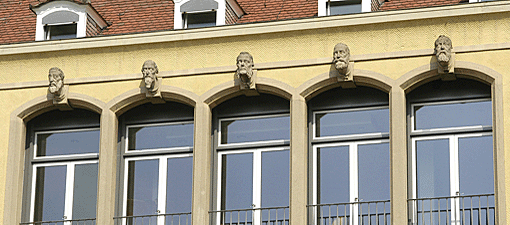
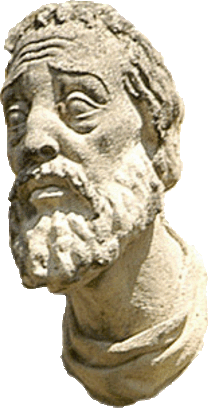
Guy de Chauliac
ca. 1300 - 1368: Biography and written work of an outstanding physician of the Middle Ages
Even as a child in his native southern France, legends surrounded his person. His medical studies took him to the most important universities of his time, including Montpellier, Paris and Bologna. In Montpellier, people still look back with pride on this great teacher today. He practiced in Montpellier, Lyon and Avignon. Contacts to Bohemia are documented. He may also have worked as an itinerant doctor on his travels through medieval Europe.
Guy de Chauliac was famous throughout Europe and as a result, members of the French and German royal families also sought his medical advice. John of Luxembourg, later known as 'the blind man', secretly traveled to Montpellier in the hope of finding relief for his eye ailment. Guy de Chauliac was also doctor to three popes. He therefore had easy access to the most important libraries in Europe.
His great textbook, the "CHIRURGIA MAGNA", is probably the most comprehensive compendium of all the medical knowledge of his time. An extensive chapter deals with ophthalmology. Guy de Chauliac passes on to us, for example, a wide variety of prescriptions, but also precise descriptions of surgical techniques, including the 'laying down of the stare'. Thanks to his numerous quotations from almost all the great medical figures of the centuries before his time, Galen, Avicenne and others had an indirect influence right up to modern times.
This manuscript remained a reference work until the 18th century. Some very fine copies and even a reprint from the 19th century have survived to this day.
L. Bellwald
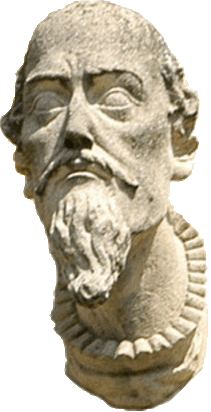
Ambroise Paré
around 1510 (Bourg-Hersent near Laval; France) - December 20, 1590 (Paris); surgeon, military doctor
Paré is regarded in his home country as the "father of French surgery" and also as an "innovator" and "pioneer of surgery". He caused a huge sensation when he ligated the artery after amputations, thus replacing the sole use of glowing iron for haemostasis, and due to his experience as a field surgeon - i.e. as a surgeon in military service - in various campaigns, he recognized that gunshot wounds were by no means poisoned, as had previously been assumed, and that they therefore did not need to be poured with boiling oil, indeed that this treatment was extremely harmful. It was also Paré who carried out trepanations - i.e. skull openings by drilling - with a good chance of survival for those affected at the time. He developed countless surgical instruments and dental instruments that are still in use today and made fundamental designs for the manufacture of prosthetic appliances. Personalities such as Paré are proof that the "craft" of surgery is capable of great achievements in every era.
It was not until the 12th century that surgery was separated from medicine. While the latter rose to become an academic subject, surgery remained "only" a "craft", and so in Paré's time and for years thereafter, surgical work was not led by academically trained doctors, but was mainly left to artisan healers such as bathers or barbers, who joined together in guilds like craftsmen. To become a member of such a "surgeons' guild", you had to complete a corresponding apprenticeship and then take an examination under the supervision of academically trained healers.
Paré had also completed an apprenticeship with a barber who also practiced surgery and then - in keeping with the custom of the time - worked as an outpatient. He was then given a permanent position at the Hôtel-Dieu in Paris - the most modern hospital in Europe at the time, where it stank of filth and pus and where several patients usually had to share a straw bed. Paré then served the French King Francis I (1494-1547), who fought several wars for Italy and European supremacy against the Spanish Emperor Charles V (1500-1558), as a field surgeon. In 1552, Paré was appointed "Chirugien du Roi", a position he also held under the king's successors. His reputation as a surgeon was so great that he was accepted into the College of Surgeons in 1554 against the opposition of the powerful Parisian medical faculty, which rejected the "simple barber". Paré practiced, designed and published until a ripe old age and died a universally honored 80 years old.
Not least due to Paré's outstanding achievements and his efforts to develop comparatively humane treatment methods - after all, it took another 300 centuries before surgical procedures under anaesthesia were possible for the first time in 1846 - France became a pioneer in the field of surgery for several centuries. In addition to the methods mentioned above, Paré improved trepanation and the treatment of bone fractures and dislocations. He expanded the range of instruments used to open the skull, which had remained almost unchanged since antiquity, by adding drills, chisels, crowbars and elevators - i.e. instruments for extracting the innards - and was thus able to trephine many skull injuries and remove blood, pus, splinters or signs of pressure. From his own experience as a military doctor, he was well aware of the consequences of operations that are difficult for us to imagine today without anesthesia. For example, he was the first to use arsenic and unslaked lime instead of annealing iron to close the groin during the frequent hernia treatments and amputations.
In addition to numerous innovations in surgery, especially war surgery, Paré described prostheses and orthopaedic devices in detail for the first time in two writings (1561 and 1575). Paré's illustrations of artificial hands, arms and legs, which he had made by a Parisian locksmith friend, are particularly well known and differed significantly from the conventional wooden makeshift devices. He published these illustrations so that other locksmiths and watchmakers could also reproduce these devices. In addition to artificial eyes, Paré recommended an artificial nose made of metal, a false moustache or covering masks to conceal facial injuries. He developed artificial front teeth made of bone, ivory or shark teeth, which were attached to the adjacent teeth with gold or silver wire, obturators to cover up palate defects caused by gunshot wounds, iron corsets to prevent spinal curvature and special boots to correct clubfoot in children. To enable men who had lost their penis down to the root to urinate standing up, he implanted artificial urethras made of ivory or wood. Paré's writings - over 20 books, which he wrote in his native French, since as a barber he was unfamiliar with Latin - provide a deep insight into the "wound medicine" of his time, in which the traditional is mixed with the new. Many of his procedures and technical devices, as well as his writings, regularly led to fierce disputes with the medical faculty, who accepted the surgeons as assistants but did not want to have their authority diminished by them.

Joseph Lister
1827-1912
The essence of his teaching, as Joseph Lister later summarized his discovery in his own words, was to systematically keep microorganisms away from surgical wounds. The phenol he used for this purpose was only one means of achieving his aims.
Lister was born on April 5, 1827 in Upton (Essex), the son of a wealthy wine merchant. The boy's interest in the natural sciences and his curiosity for the hidden awoke at an early age. His father Jack Joseph Lister, who became world-famous for his discovery of achromatic lenses, with which he made a significant contribution to the perfection of the microscope, probably had a decisive influence. Even at a young age, Lister announced his desire to become a surgeon, a plan that did not meet with his father's approval before any antisepsis and anesthesia. Instead, he insisted that Joseph Lister first complete his Bachelor of Arts degree.
During his medical studies, he was significantly influenced from the outset by his physiology professor William Sharpey. It is characteristic of Lister that he published reports on the "hospital gangrene" while still a student. However, it would be another thirteen years before his first experiments on antisepsis, in which he postulated microorganisms as the causative agent.
After his brilliant state examination in 1852, it was Sharpey who advised the financially independent Lister to spend a month with the now world-famous surgeon James Syme in Edinburgh and then a few months at schools on the mainland. However, the young Lister and James Syme, Lister's future father-in-law, soon became so close that the latter offered his young pupil a permanent post as a surgeon at Edinburgh Hospital. A few years later, in 1859, Lister, who on the one hand did not want to leave his father-in-law Syme and on the other hoped for a chair in London, decided with a heavy heart to accept a vacant professorship of surgery in Glasgow. From numerous letters to his father, his closest confidant, we know that Lister was very doubtful that he would be accepted by the students. However, this turned out to be completely unjustified, for in a very short time he had gathered the largest audience in the kingdom around him. His greatest concern, however, was the alarming and ever-increasing mortality rate in the surgical department of his hospital, which was under the management of the extremely frugal administrative board. Lister's efforts to maintain a minimum level of cleanliness, which inevitably entailed costs, met with strong resistance. But despite cleanliness, sepsis, always the greatest danger in surgery, was so rampant that it was commonly said that anyone undergoing surgery was exposed to greater dangers than on the battlefield. Through microscopy, Lister was well acquainted with all phases of the inflammatory process, although the causes of this phenomenon, which led to death in some but not in others, remained a complete mystery to him.
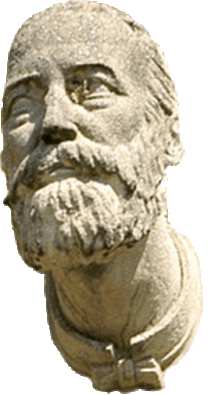
Ernst von Bergmann
1836 - 1907
Trepanation, i.e. the surgical opening of the skull, is one of the oldest procedures known from human history. Neolithic bone finds with signs of surviving trepanations have also been described in Germany. Such operations were probably carried out more for ritual and religious reasons. However, the actual history of German neurosurgery only began towards the end of the 19th century, when interested autodidacts such as Ernst v. Bergmann (1836 - 1907) and Otfrid Foerster (1873 - 1941), coming from the field of general surgery or neurology and often prompted by wartime events, gained their first experience in the surgery of the nervous system. Fedor Krause (1857 - 1937) habilitated in Halle a. d. Saale in 1887 on a neurosurgical topic - the beginning of scientific neurosurgery in Germany. In 1911, Krause was the first to describe surgical approaches to the cerebellopontine angle, the epiphysis (pineal gland) and the origin of the trigeminal nerve. In 1932, the Würzburg surgeon Hans König (1866 - 1952) sent his assistant Wilhelm Tönnis (1898 - 1978) to Stockholm. There, Herbert Olivecrona (1891 - 1980), influenced by his American role models Harvey Cushing (1866 - 1939) and Walter Dandy (1886 - 1946), practically single-handedly launched Swedish neurosurgery. Back in Würzburg, Tönnis set up the first independent neurosurgical department in Germany in 1934. In 1935 he moved to Berlin and in 1936 founded the Zentralblatt für Neurochirurgie, the oldest neurosurgical journal in the world.
The turmoil of war prevented the journal from being distributed abroad from 1943 onwards, so that the American Journal of Neurosurgery took its place in 1944. To this day, however, the Zentralblatt is the official organ of the German Society for Neurosurgery (DGNC), which was founded in 1947. After the war, the schools separate - Tönnis is the teacher of numerous neurosurgeons in the West, while in Leipzig Georg Merrem (1908 - 1971) takes over the groove. The further development of the surgical microscope in the 1960s, the introduction of computer tomography (CT) in 1972 and magnetic resonance imaging (MRI) in 1978 revolutionized neurosurgery in Germany as well; however, these possibilities only became available to the majority of neurosurgeons east of the "Iron Curtain" after 1989. "Joint meetings" of the DGNC with the national associations of numerous countries (ultimately Brazil, Japan and Switzerland), but also the participation of German clinics in numerous international study projects ensure the international exchange of knowledge and technology today.
At the end of the "decade of the brain", proclaimed by US President George Bush in 1989, increasing knowledge about the functions of the central nervous system is also benefiting neurosurgery: together with advances in imaging, data processing and surgical techniques, this new knowledge is enabling the targeted and predictable influencing of higher nerve functions for the first time, thus expanding the possibilities of functional neurosurgery. On the one hand, the aim will be to create genuine neuroprosthetics, the possibility of replacing lost neurological functions by using organically integrated implants that communicate with the biological system. On the other hand, increasing possibilities will also bring new responsibilities for the discipline. Even if the feasibility of a "mind probe" is very doubtful for fundamental reasons, the neurosurgery of the future will work closer to the actual core of the human being than any other discipline.
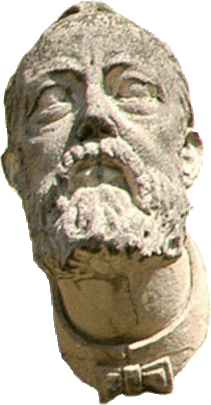
Christian Theodor Billroth
April 26, 1829 (Bergen auf Rügen) - November 6, 1894 (Opatija in Istria/Croatia); surgeon
As the founder of modern surgical techniques, Theodor Billroth is one of the most important surgeons of the 19th century. He is the creator of gastrointestinal surgery; his surgical techniques for gastric resection opened up a completely new field of work for medicine and new ways of healing for patients. Billroth also improved existing surgical methods and developed completely new ones. These included the complete opening of the larynx, laryngectomy for cancer, operations on the oesophagus for cancer, tongue cancer and thyroid disease, surgery on the liver, spleen and urinary bladder and vaginal removal of the uterus.
Theodor Billroth studied medicine in Greifswald, Göttingen and Berlin. In 1853, he became an assistant to Bernhard Rudolph Konrad von Langenbeck (1810-1887) in Berlin, where he learned the basics of plastic surgery and the construction of surgical instruments. Under von Langenbeck, he habilitated in the subjects of surgery and pathological anatomy. Billroth turned down an appointment as professor of pathology in Greifswald and instead accepted an appointment to the chair of surgery in Zurich in 1860. During his years in Zurich, which were particularly fruitful for him in scientific terms, he wrote his well-known pathological-anatomical works. It was here that he laid the foundations for "scientific surgery" and thus raised his discipline to the heights at which it would later celebrate its great triumphs with Ernst Gustav Benjamin von Bergmann (1836-1907), August Karl Gustav Bier (1861-1949), Ernst Ferdinand Sauerbruch (1875-1951) and others.
In 1867, Theodor Billroth took over the II. Chair of Surgery at the University of Vienna in 1867. He declined the honorable call to become von Langenbeck's successor in Berlin. Years of unprecedented work began in Vienna, crowned with many developments. Thanks to his broad training, Billroth was able to combine clinical and pathological anatomy in an outstanding way and make them usable for modern scientific-experimental surgery, which earned him the honorable reputation of a "natural scientist in a surgeon's coat". His main interest was in the pathology and surgery of tumors.
In 1874, Theodor Billroth was able to remove a larynx for the first time before he began his epoch-making gastric resections. On 29 January 1881, he performed the first successful gastric resection on a tumor patient in Vienna, who survived for years thanks to this operation. Billroth refined this technique of end-to-end union of the stomach stump and duodenum ("Billroth operation I") to perfection in 1885 with the blind closure of the duodenum and side-to-end union of the jejunum and stomach stump ("Billroth operation II").
It was the introduction of antisepsis that made Theodor Billroth's surgical success possible. He was therefore an important promoter of the technical, organizational and personnel aspects of hospital and nursing care. Billroth was a great man, a brilliant physician, the ideal of the German university teacher, loved by his students and assistants and revered by his patients. As a highly musical man, he was friends with the composer Johannes Brahms (1833-1897), who had taken up permanent residence in Vienna in 1878, and the musicologist Eduard Hanslick (1825-1904). Billroth was a strong advocate for his disadvantaged Jewish colleagues at German-speaking universities. As late as 1883, he complained that "crooked noses decide who is appointed to professorships at German universities".
Above the main entrance to the surgical clinic
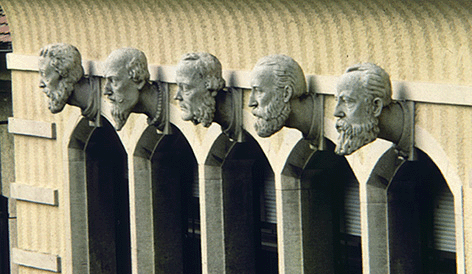
| The illustration depicts the following personalities (from left to right): | ||
| G. de Chauliac | A. Paré | J. Lister | E. v. Bergmann | C. T. Billroth |
University Medical Center Freiburg
Hugstetter Straße 55
79106 Freiburg
Phone: 0761 270-0
info@uniklinik-freiburg.de

